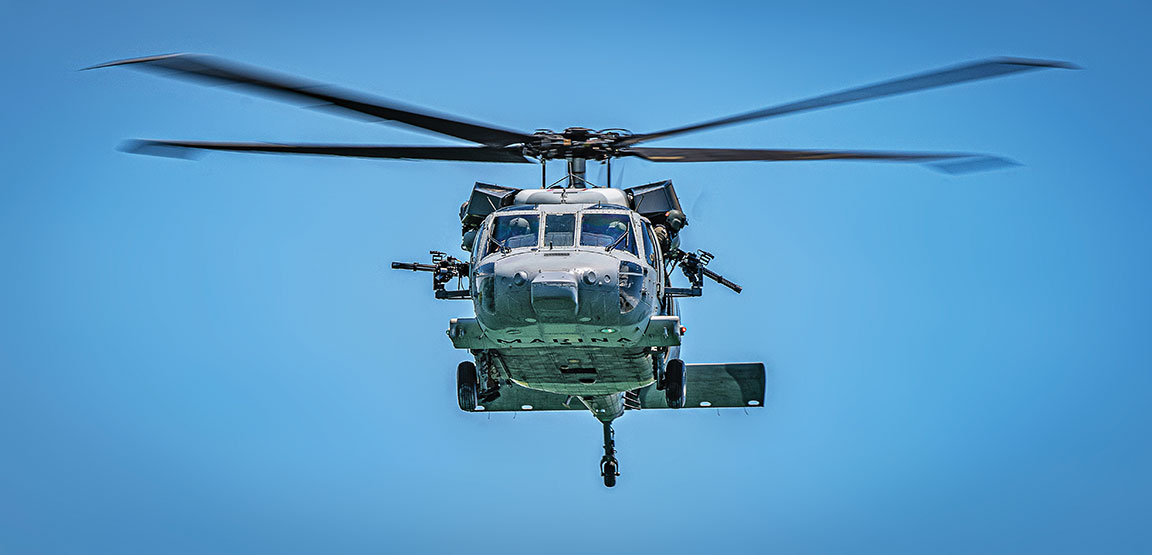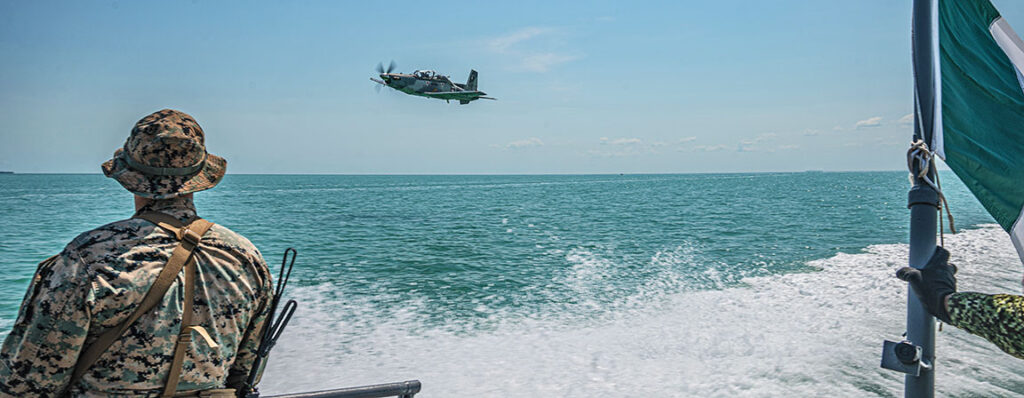A U.S. Marine watches a Mexican Hawker Beechcraft T-6C Texan II aircraft practice interdiction operations during Tradewinds 2022 at Chetumal Bay, Mexico.
MEXICAN SECRETARIAT OF NATIONAL DEFENSE. Photos by SGT. MATTHEW TEUTSCH/U.S. MARINE CORPS
Drug trafficking is a global problem that affects all societies, including Mexico, where the geography includes large mountainous terrain and remote areas. That combination makes the airspace one of the most frequently used routes by organized crime to transport illegal substances.
Airspace offers logistical advantages for drug traffickers, resulting in more direct and virtually obstacle-free routes that let criminals avoid road checkpoints and seaport inspections. In response to this challenge, Mexico’s Secretariat of National Defense (SEDENA) implemented a series of measures designed to protect the sovereignty of the nation and contribute to the fight against drug trafficking.
First was the integration of an Air Operations Coordination Center, which was commissioned on February 16, 1992. It included an operations room to monitor illicit flights. The coordination center on August 1, 1996, became an Air Interdiction Subsection to receive and disseminate information on illicit air trafficking.
At that time, aerial surveillance was conducted through information obtained from visual reconnaissance flights by Mexican Air Force aircraft and was enhanced by data provided by military radar. The military did not have the human resources, computer and communications infrastructure necessary for a coordinated effort with surface forces.
The Integrated Air Surveillance System (SIVA) was created in December 2004 with a Command, Control, Computer, Communications, and Intelligence Center (C41) to optimize the results of the General Strategy for Drug Control. SIVA increased its capabilities in 2018 by upgrading its Command Center to a C4ISR (Command, Control, Computers, Communications, Intelligence, Surveillance, and Reconnaissance Center) level, with ground detection assets deployed in the southeast area of the country, airborne (surveillance platforms), unmanned aerial systems, and other support aircraft fulfilling their aerial surveillance missions.

The systems let authorities support and use real-time information on unauthorized aircraft movements flying over the Mexican territory. To prevent transnational criminal organizations from violating the national airspace sovereignty, SEDENA lobbied for the Mexican Airspace Protection Law to form a legal framework to inhibit this crime. The law was approved by the Mexican Congress and went into effect on March 2, 2023.
Mexico’s government said the new law was necessary, noting that in 2019, the U.S. Customs and Border Protection agency reported 118 tons of cocaine entered the U.S. by air. This legislative act led SIVA to become the National Center for Airspace Protection and Surveillance (CENAVI), a significant leap forward in the surveillance and protection strategy for Mexican airspace. This change focuses on implementing an interinstitutional strategy with human, material and technological resources from the Secretariat of National Defense; Secretariat of the Navy; Secretariat of Security and Citizen Protection; Secretariat of Infrastructure, Communications, and Transportation; and Secretariat of the Interior, by designating CENAVI as the coordinating body of the efforts of each agency for the surveillance and protection of Mexican airspace.
The objectives of the interinstitutional strategy are to strengthen the state’s capabilities to carry out airspace surveillance over national territory; track and detect illicit aircraft and vessels; increase coordination and cooperation with other countries in the fight against drug trafficking; levy administrative sanctions; and apply penalties on those who allow illicit activities.
This change shows a continuous commitment and an adaptive response by Mexican authorities to address the complexities inherent in drug trafficking and other illicit activities in the country’s airspace, and the combination of advanced technology and highly skilled personnel has generated positive results in the interception of organized crime aircraft.
Through its technological equipment, CENAVI can carry out national airspace surveillance, contributing to the protection of national security and guarantee internal security to achieve peace and prosperity for the nation.

